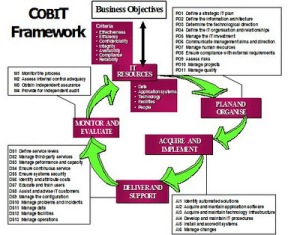COBIT merupakan standar yang dinilai paling lengkap dan menyeluruh sebagai framework IT audit karena dikembangkan secara berkelanjutan oleh lembaga swadaya profesional auditor yang tersebar di hampir seluruh negara. Dimana di setiap negara dibangun chapter yang dapat mengelola para profesional tersebut.Target pengguna dari framework COBIT adalah organisasi/perusahaan dari berbagai latar belakang dan para profesional external assurance. Secara manajerial target pengguna COBIT adalah manajer, pengguna dan profesional TI serta pengawas/pengendali profesional. Secara resmi tidak ada sertifikasi profesional resmi yang diterbitkan oleh ITGI atau organisasi manapun sebagai penyusun standar COBIT. Di Amerika Serikat standar COBIT sering digunakan dalam standar sertifikasi Certified Public Accountants (CPAs) danChartered Accountants (CAs) berdasarkan Statement on Auditing Standards (SAS) No. 70 Service Organisations review, Systrust certification or Sarbanes-Oxley compliance.
o Effectiveness
Menitikberatkan pada sejauh mana efektifitas informasi dikelola dari data-data yang diproses oleh sistem informasi yang dibangun.
o Efficiency
Menitikberatkan pada sejauh mana efisiensi investasi terhadap informasi yang diproses oleh sistem.
o Confidentiality
Menitikberatkan pada pengelolaan kerahasiaan informasi secara hierarkis.
o Integrity
Menitikberatkan pada integritas data/informasi dalam sistem.
o Availability
Menitikberatkan pada ketersediaan data/informasi dalam sistem informasi.
o Compliance
Menitikberatkan pada kesesuaian data/informasi dalam sistem informasi.
o Reliability
Menitikberatkan pada kemampuan/ketangguhan sistem informasi dalam pengelolaan data/informasi.

Framework COBIT terdiri dari 34 high-level control objective, dimana tiap-tiap IT proses dikelompokkan dalam empat domain utama:
1. Planning and Organization
mencakup strategi dan taktik yang menyangkut identifikasi tentang bagaimana TI dapat memberikan kontribusi terbaik dalam pencapaian tujuan bisnis organisasi sehingga terbentuk sebuah organisasi yang baik dengan infrastruktur teknologi yang baik pula.
PO1 Define a strategic information technology plan
PO2 Define the information architecture
PO3 Determine the technological direction
PO4 Define the IT organisation and relationships
PO5 Manage the investment in information technology
PO6 Communicate management aims and direction
PO7 Manage human resources
PO8 Ensure compliance with external requirements
PO9 Assess risks
PO10 Manage projects
PO11 Manage quality
2. Acquisition and Implementation
identifikasi solusi TI dan kemudian diimplementasikan dan diintegrasikan dalam proses bisnis untuk mewujudkan strategi TI.
AI1 Identify automated solutions
AI2 Acquire and maintain application software
AI3 Acquire and maintain technology infrastructure
AI4 Develop and maintain IT procedures
AI5 Install and accredit systems
AI6 Manage changes
3. Delivery and Support
domain yang berhubungan dengan penyampaian layanan yang diinginkan, yang terdiri dari operasi pada sistem keamanan dan aspek kesinambungan bisnis sampai dengan pengadaan training.
DS1 Define and manage service levels
DS2 Manage third-party services
DS3 Manage performance and capacity
DS4 Ensure continuous service
DS5 Ensure systems security
DS6 Identify and allocate costs
DS7 Educate and train users
DS8 Assist and advise customers
DS9 Manage the configuration
DS10 Manage problems and incidents
DS11 Manage data
DS12 Manage facilities
DS13 Manage operations
4. Monitoring
semua proses TI perlu dinilai secara teratur dan berkala bagaimana kualitas dan kesesuaiannya dengan kebutuhan kontrol
M1 Monitor the process
M2 Assess internal control adequacy
M3 Obtain independent assurance

